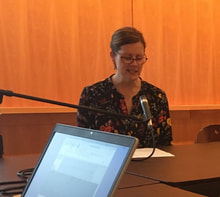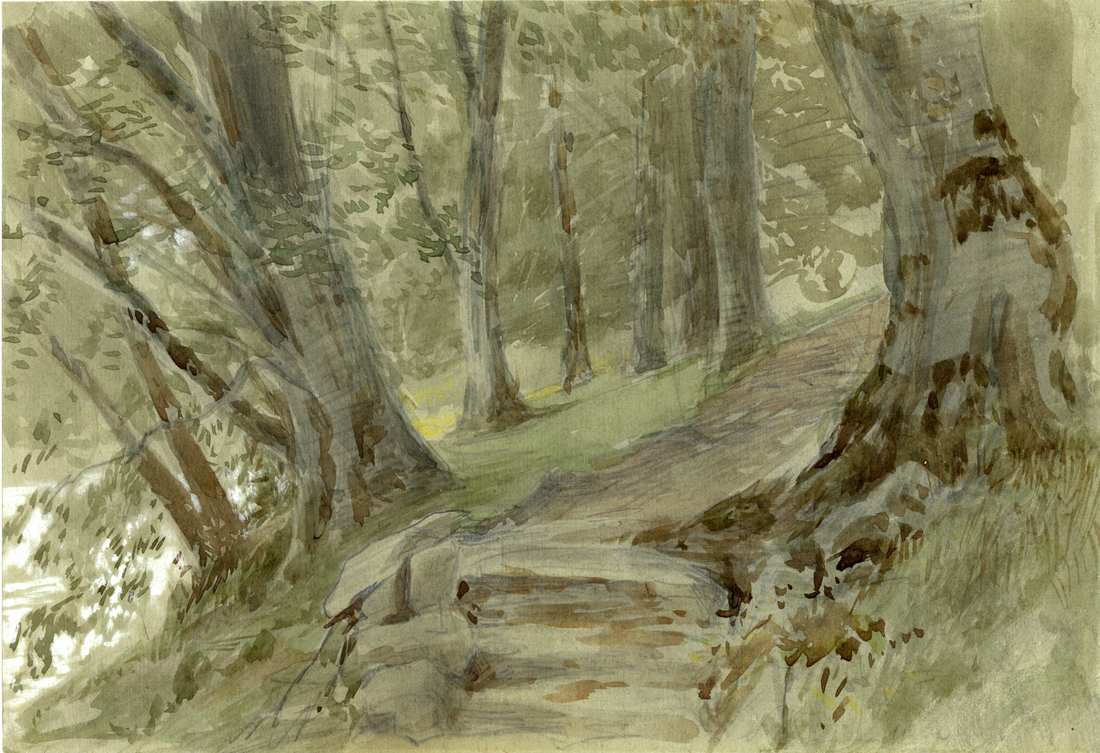...walk into a museum.

People keep telling us that Delaware is such a small state that unlike the six degrees of separation in the rest of the world, here it's only one or two. It must be true because within a few months of arriving, I received a call from the Delaware Art Museum asking me to get involved in a special project!
In conjunction with the new exhibit Eye on Nature: Andrew Wyeth and John Ruskin, the curator asked several leaders from the faith community to offer recorded responses to specific paintings to be used in the audio guide. I was honored to be asked as an Episcopalian artist. Among the others participating are some wonderful folks who are Jewish, Muslim, Quaker and non-denominational Christian.
The exhibition explores how Wyeth and Ruskin, though living 100 years apart, "shared a lifelong obsession with the close observation and finely rendered imagery of the world around them." The question for us was, "What relevance does the work of art, or Wyeth/Ruskin’s act of looking at nature, have for our own day and age?"
John Ruskin, I have since learned, was also a watercolorist and urban sketcher! He took his journal everywhere with him and sketched on all his travels, around home and abroad. My 19th century kindred spirit!
In conjunction with the new exhibit Eye on Nature: Andrew Wyeth and John Ruskin, the curator asked several leaders from the faith community to offer recorded responses to specific paintings to be used in the audio guide. I was honored to be asked as an Episcopalian artist. Among the others participating are some wonderful folks who are Jewish, Muslim, Quaker and non-denominational Christian.
The exhibition explores how Wyeth and Ruskin, though living 100 years apart, "shared a lifelong obsession with the close observation and finely rendered imagery of the world around them." The question for us was, "What relevance does the work of art, or Wyeth/Ruskin’s act of looking at nature, have for our own day and age?"
John Ruskin, I have since learned, was also a watercolorist and urban sketcher! He took his journal everywhere with him and sketched on all his travels, around home and abroad. My 19th century kindred spirit!
I look forward to seeing the complete exhibition and the works by these two masterful painters. If you are curious about my response to "Path at Brantwood" please read on...
We are looking at John Ruskin’s watercolor painting, “Path at Brantwood.” We see a sketch of steps leading along a path in the woods, a paused moment during a familiar walk around Ruskin’s home.
I imagine Ruskin tromping around his estate on the well-worn path by the lake and through the trees, taking a break from concerns and responsibilities. He stops, steeped in his own senses – breezes ruffling the leaves; sun seeping through the branches and shadows moving over mossy steps – and he is filled with a love of this solitary place. Of course he stops to sketch, each mark emphasizing the memory of this moment.
This world of discord and dissonance can still offer us rare moments of overwhelming peace. I think we often encounter them when we are alone in nature, away from the endless chatter of television and phones -- when we make time to feel deeply and open our hearts to God’s creation around us.
I find these moments when I am painting, when I must stop to study the curve of a branch or the colors in a flower. When I stop to really, really look at what is in front of me. As painter Georgia O’Keeffe said “When you take a flower in your hand and really look at it, it's your world for the moment.”
I am a travel sketcher, like Ruskin, and I appreciate the urge to stop and pull out my paints. At the beach or along the Brandywine, I remember a painted scene better than anything I’ve ever photographed. Why? Because I have slowed my pace, quieted my worries and stopped to look closely at something I love.
My name is Caroline Coolidge Brown. As a printmaker, painter and urban sketcher, my Christian faith guides my curiosity and passion for art of all kinds.
I imagine Ruskin tromping around his estate on the well-worn path by the lake and through the trees, taking a break from concerns and responsibilities. He stops, steeped in his own senses – breezes ruffling the leaves; sun seeping through the branches and shadows moving over mossy steps – and he is filled with a love of this solitary place. Of course he stops to sketch, each mark emphasizing the memory of this moment.
This world of discord and dissonance can still offer us rare moments of overwhelming peace. I think we often encounter them when we are alone in nature, away from the endless chatter of television and phones -- when we make time to feel deeply and open our hearts to God’s creation around us.
I find these moments when I am painting, when I must stop to study the curve of a branch or the colors in a flower. When I stop to really, really look at what is in front of me. As painter Georgia O’Keeffe said “When you take a flower in your hand and really look at it, it's your world for the moment.”
I am a travel sketcher, like Ruskin, and I appreciate the urge to stop and pull out my paints. At the beach or along the Brandywine, I remember a painted scene better than anything I’ve ever photographed. Why? Because I have slowed my pace, quieted my worries and stopped to look closely at something I love.
My name is Caroline Coolidge Brown. As a printmaker, painter and urban sketcher, my Christian faith guides my curiosity and passion for art of all kinds.

 RSS Feed
RSS Feed